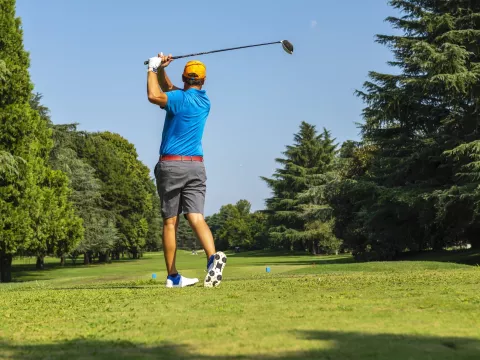- AdventHealth

AdventHealth and Rothman Orthopaedics are joining forces to lead in pioneering research and innovative care in Central Florida. Together, we’re transforming the field of orthopedics. This article originally appeared on RothmanOrtho.com.
Out of all of the sports you can think of, golf probably appears to be one of the safest. There are no tackles, no collisions, and no physical fighting involved in the game. However, golfers are not immune to injury while on the course. Hip pain from golf can result from swinging the golf club over and over, which puts pressure on the hip joint and surrounding muscles. Pain can be also exacerbated if the swing is not executed correctly or smoothly. This repetitive, twisting motion and the pressure placed on the hips may cause discomfort and hinder a golfer’s ability to play.
For this kind of injury, the specialists at Rothman Orthopaedic Institute recommend our eBook, Hip Health: Relieving Pain & Restoring Mobility. This text provides useful information on keeping your hips healthy, alleviating current pain, and avoiding future hip injuries. If you are currently suffering with hip pain from golf, below are three treatment options that can help you regain mobility and get you back on the course.
How to Treat Your Hip Pain From Golf
- Rest for recovery. If your golf swing is causing you hip pain, it should come as no surprise that taking a break from playing is recommended. You may have strained your hip from twisting your body while on the course. In this case, use the RICE method of rest, icing, compression, and elevation, before beginning a rehabilitating exercise program. Your doctor may also suggest using crutches for the first few days to reduce the amount of pressure put on the hip joint. Another tip for relaxing the injured area is to apply heat during your rest period. Heat can help reduce the pain and increase mobility.
- Exercise for strength. After taking a break from playing golf, the next step in hip pain recovery is strengthening the injured area. Some of the target muscles you’ll want to strengthen to support your hips are those in your buttocks and the inner, outer, and back of your thighs. Creating a stronger muscle framework will make your body better able to absorb the strain involved in golfing.
While performing hip exercises is an important part of preventing future hip injuries, you should not add any conditioning program to your daily routine without your doctor’s approval. Discuss with her or him which exercises are the best for strengthening hips and plan out a routine that works for you.
- Stretch for flexibility. Make sure to stretch before and after your exercise routine as well as your future golf games. No matter what physical activity you are doing, stretching beforehand prepares your muscles for exercise, and stretching afterwards elongates and relaxes the muscles when they are tired and tight. Stretching your muscles relieves tension and lessens the risk of injury. In any rehabilitating conditioning program, stretching and exercise go hand-in-hand. Ask your doctor about increasing the flexibility around your hips; this should, in turn, increase the speed of your recovery.
These three steps in hip pain treatment should help ease the pain and get you back to playing the game you love. Once you are back on the course, though, be careful and ease into the movement. Ask a professional to evaluate your stance and swing while playing golf to assure your form is correct and safe. Sometimes, little changes in your step, posture, hand placement, and swing can make a huge difference in how you feel and your performance level.
Here for Your Joint Health
Have you heard? We've joined forces with Rothman Orthopaedics, one of the nation’s top orthopedic programs, to create a groundbreaking, comprehensive specialty network that is the new gold standard in quality, innovation, research and whole-person care.
This visionary partnership will expand the possibilities for world-class treatment for a variety of orthopedic services, including joint replacement, fracture care, reconstruction of the knee, shoulder, elbow and hand and treatments for arthritis and osteoporosis. Together, our leading-edge providers comprise a powerhouse of innovation focused on developing new treatments and widening accessibility to top-level care while raising the bar for orthopedic excellence.
Learn more at TransformingOrtho.com.



